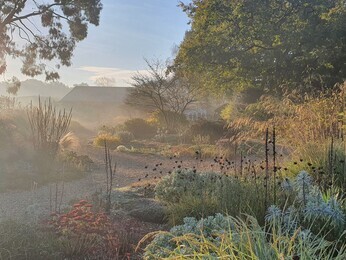
Drought 2022
How did our garden, renowned for its ability to cope in drought, actually fare?
This summer there was a drought and heatwave across the entire UK. During the heatwave we experienced some of the highest temperatures ever for this part of the world. Rather than this summer being a rarity, the last time this happened was only four years ago, in 2018. We are known for our drought resistant Gravel Garden, but what happened across the rest of the Garden? In writing this blog we hope to give you some insight into how our garden coped in the extreme heat and extended drought, in which aspects we failed, where we were successful, and where we learned valuable lessons for the next time.
Firstly, we need to clear up some common misconceptions about irrigation in the Gardens. Beth and Andrew had gardened in this part of East Anglia for many years prior to building the house and garden at Elmstead Market and knew it had a drier-than-average climate compared to much of the UK. Elmstead Market is only a few miles from St. Osyth, officially the driest place in the country. They chose this spot to build their house and garden because they realized that the stream running through the property could provide a constant source of water.
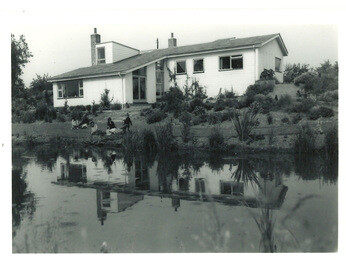
Beth and Andrew chose this site for their new house and garden because of the stream running though the property
Having created a large part of the garden between 1960 and 1990, Beth designed the drought resistant Gravel Garden in 1992 to see how plants would respond to not being watered. She had always intended that the Gravel Garden wasn't to be irrigated, as it was here that the drought resistant planting experiment was to take place. But the rest of the garden has always been watered as and when necessary. We don’t have a watering system installed but we have access points in the woodland and on the nursery where we can attach a hose. We use a series of huge oscillators; the water comes from a borehole and a pump increases the water pressure. A lot of water is chucked out over a short period of time.
With informed plant choices however, most plants rarely show signs of water stress, especially in the Water Garden near the ponds, in the Gravel Garden (obviously) and in the alpine Scree Garden. The garden that wilts first is always the Woodland Garden where the under-story plants (shrubs, small trees, perennials and ground-cover) are competing with the root systems of a well-established oak woodland. Also, over the years some larger trees that once provided shade have been lost, so some shade-loving plants have found themselves in direct sunlight for part of the day, adding to their over-all summer stresses.
For different reasons, some of the new planting in the Reservoir Garden has struggled in drier weather too. It was redesigned in 2017-18 and has been experimental on a par with the Gravel Garden. Although at the same elevation as the free-draining, sandy-soiled Gravel Garden, the Reservoir Garden is completely different having a heavy clay that came from the excavation of the reservoir which is situated at the bottom of the slope. The heavy soil here meant there could be a different plant palette to that of the Gravel Garden, and there was an opportunity for plants that prefer more moisture and that can cope with a heavy soil in the winter. The intention was that it would be irrigated similarly to the rest of the garden. But with good plant choices, it simply hasn’t been necessary. Although a few plants were lost at the beginning through not watering, the decision was made that it wasn't to be irrigated, with a ‘wait and see’ approach.
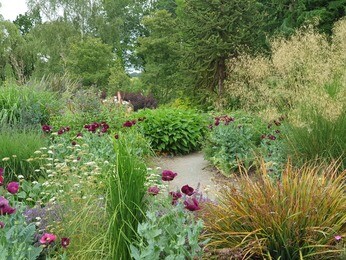
Part 1: 2018
Background to the drought: rainfall patterns.
We often have dry late springs and early summers, in the months of April, May and June. For example, in a typical year like 2020, in the six weeks between 16th March and 27th April, we recorded only 2mm of rainfall, and for the month between 4th May to 1st June there was none.
In the lead up to the drought of 2018, the amount of rain at the gardens started to drop off in April. Our records show a good March total of 65mm, with regular rainfall amounts each week throughout that month. However, in April, while in the first two weeks we recorded 45mm and 13mm respectively, in the week ending 16th April, we had only 2mm. After that we recorded 0mm until the week ending 28th May when we recorded 42mm.
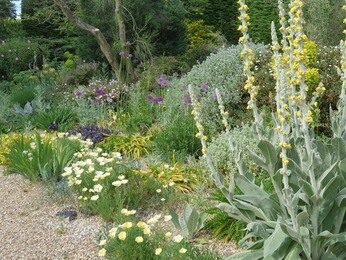
The Gravel Garden in spring
After these diminishing amounts, the drought kicked in. In the week ending 4th June, there was 3mm, then there was nothing at all until 8 weeks later- week ending 30th July- when we recorded 19mm. However, once the drought had broken in August, we recorded regular rainfall of between 10 and 20mm each week.
2018 was also the year that the UK had an unprecedented heatwave where temperatures remained over 30C for weeks. For those reading this from outside of the UK where this isn’t a big deal, you must remember that the flora and fauna of a country is adapted to the climate of that country, and any sharp increase (or decrease) in temperature is going to affect their survival. Suddenly plants weren’t just dealing with dry soil, but also scorching temperatures that they weren’t used to.
2018: The Gravel Garden
Many of us hadn’t seen the drought resistant planting in the Gravel Garden put to the test until 2018. What we learned in the Gravel Garden that year better prepared us for the challenges we faced across the whole garden in 2022.
We had always been told that when Beth first planted the Gravel Garden, if plants began showing signs of drought stress, she chopped everything back to mitigate the water loss through their leaves. Then, when conditions were wetter, they would start putting out fresh growth.
So, where we saw signs of crisping and wilting we happily chopped back the growth of plants like catmint Nepeta racemosa, hardy geraniums, and periwinkle Vinca minor. To our horror this made matters much worse as the strength of the sun promptly scorched the crowns where young growth was to start. The top growth we’d removed had been acting as shade and sunscreen, however brown and crispy it had become. All we’d done was remove this vital natural protection. We hadn’t factored in the strength of the sun, just the dryness of the soil.
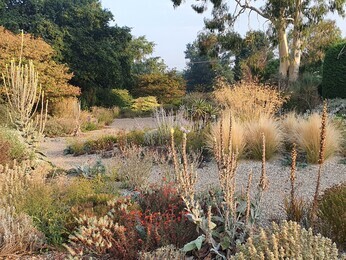
Although the Gravel Garden in August may not be lush and green, it still has lots of interest and structure
What we were finally able to see firsthand was how plants have adapted to conditions like these. Some, like Nepeta racemosa, go dormant in the extremes of summer, like they equally go dormant in the difficult conditions of winter. Instead, they do all their growing in the milder conditions of spring and early autumn. Other plants like Lychnis coronaria or Verbena bonariensis mitigate dying by producing plenty of seed that germinates quickly and can replace the parents.
Whichever way they do it, almost all the plants in the Gravel Garden were flourishing again by the following spring.
From an aesthetic point of view, we also learned it was better to keep almost everything standing. In an average year, plants are cut down once they’d finished flowering ready for a second flush of foliage – and flowers if we we're lucky - or to make room for other plants coming through in a succession of interest. There was also an idea that seed-heads and brown stems only belong in an autumnal or wintry landscape. But cutting everything back in the Gravel Garden in midsummer 2018 simply wasn’t an option. There would have been barely anything left to see, and it would have resembled the garden as it is in winter, with only the bare structure visible. We decided plants like Asphodeline liburnica, Foeniculum vulgare (fennel) Verbascum chaixii (mullein) and many others should be left uncut. Interestingly, the conditions that year were such that many mid-to-late-summer flowering plants failed to set seed at all, especially those that were growing and coming into flower at the height of the heatwave. This was of deep concern for the propagation team, but a great relief to the gardeners. Normally, not cutting the plants back means all the seed produced drops to the ground – and usually there is a lot of weeding/editing to be done as a consequence!
In summary, we learned some important lessons:
- Don’t cut back plants in high temperatures even if the foliage is showing signs of drought stress.
- Aesthetically, a drought tolerant garden isn’t necessarily full of lush greenery in a drought.
- Even drought tolerant plants can die, as their coping mechanism may be to produce a lot of seed - usually spring and early summer flowering plants. (Though it depends on whether the drought or heatwave hits at a time the plant is adapted to or not. Which leads on to the next point…)
- Seed production can be compromised if that plants’ flowers are peaking during the height of the heatwave and drought.
With everything we’d learned, we thought we were well prepared for the next drought. But 2022 had its own set of challenges and proved to be another difficult year – only this time it was to extend across the whole garden.
Part 2: 2022
The beginning
In 2022, we had the usual low rainfall in April and May, recording 0mm for three weeks between 11 April and 2 May. May and June were better: steady amounts with monthly totals of 55mm and 42mm respectively.
But in the last week of June only 1mm was recorded – and that was the last rainfall until 17 August. The drought didn’t break in the same way as in 2018 either. On 16 August we had 3mm, the next day we had 7mm. We then recorded just 1, 2, and 3mm each week until 12 September. The total rainfall between 20 June and 15 September was 16mm, seven weeks of which were at 0mm.
The heat was intense for the UK too. It wasn’t as prolonged as in 2018, but it was certainly hotter.
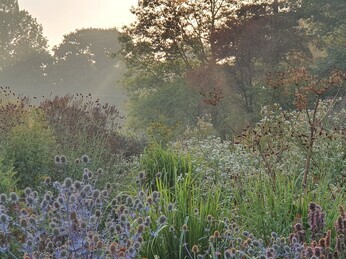
The reservoir garden July-August 2019. With average rainfall levels, it's never irrigated
Decisions to make
The normal signs of dry stress started to show in the woodland in early July, and it was the usual suspects that were struggling – namely hydrangea. As soon as we were in work that morning, we set up the huge oscillator pipes and big hoses in the woodland area ready for a day of watering. But before we could open the water valves and turn on the pump, Estate Director Gerard stopped us. He asked if we were aware how little water was left in the borehole.
Now, our nursery is irrigated by ground water from our borehole rather than mains water. If our irrigation tank can’t refill from the borehole, it automatically switches to extracting water from the stream-fed ponds in the Water Garden. When this happens it’s always a bit depressing. The ponds are such a prominent feature of the Water Garden, and when the water levels are low (which they naturally are in the summer anyway) it can look unsightly and create its own set of problems as the water flow between the ponds can stop completely. Duckweed is one of these problems, as it can completely cover a pond surface if there’s little or no flow.
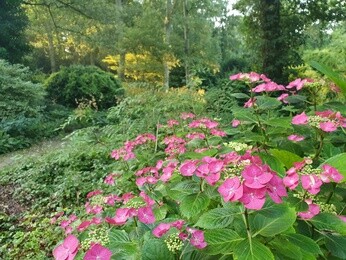
The hydrangeas in the Woodland Garden are normally the first shrubs to show signs of drought stress
After talking to Gerard, we came to an agreement across all departments: there was to be no blanket-coverage watering anywhere. For example, the automatic timed watering systems weren’t to be set overnight on the nursery and instead were only to be turned on, area by area, by a member of staff when they judged it was necessary. This irrigation ban meant that in the garden we couldn’t use the oscillators. They pump a lot of water onto an area, and it’s difficult to direct that water efficiently.
Instead, we began a routine of filling trugs with water, and carrying them on the back of our little vehicles – about 10 trugs at a time – and pouring the water directly at the base of plants that needed it. This way we were targeting the roots as best we could. We also set up trickling hoses at the base of larger shrubs or smaller trees. This water came from the borehole, but without the pump and with the valves not fully open, only relatively small amounts of water are used.
As the drought progressed, we had to decide which plants to focus on as it was impossible to cover the whole seven-acre garden in this way. We decided newly or recently planted trees and shrubs were a priority, as well as new perennial plantings. After these, the list continued to shrubs, mainly situated in the Woodland, though there were a few along the shady walk in the Water Garden where the elevation means they get little or no water from the ponds but are in competition with large established trees.
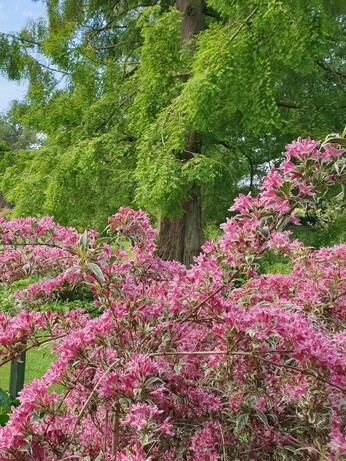
These were shrubs planted many years ago, and so should have been established enough not to have problems. But as mentioned at the beginning of this article, Beth never intended everywhere to remain un-irrigated, just the Gravel Garden. The first of these established shrubs to show signs of drought stress were the hydrangeas, including (eventually) the climbing hydrangeas H. anomala subsp. petiolaris, of which we have quite a few climbing up the trunks of oaks in the Woodland Garden. Next to wilt were Viburnum x bodnantense, Deutzia rosea, Weigela florida, Ribes laurifolium, Ribes sanguineum, and both Sarcococca hookeriana and S. confusa. Eventually even tree-like specimens of Euonymus europaeus started to struggle. It must be mentioned here that the soil in the Woodland Garden is incredibly sandy, and together with the competition from much bigger trees, it was astonishing how long some of these plants went without showing any signs of stress at all.
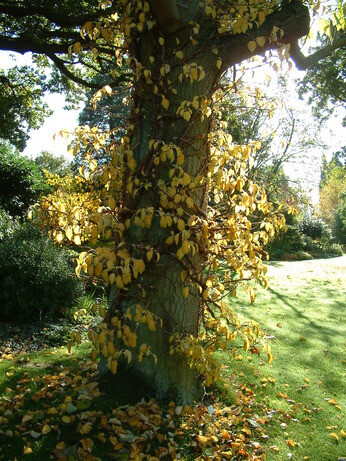
One of our Hydrangea anomala subsp. petiolaris growing up an oak tree in the woodland, in autumn
We decided that trees were just too big, and therefore needed too much water to be looked after. We were also beginning to realize just how much irrigation there must have been in the past. Either that, or how much rainfall patterns have changed since these trees that were struggling had been planted by Beth and Andrew decades ago, and so surely had well established root systems. The trees most obviously struggling were the Rowans or Mountain Ash, Sorbus aucuparia and S. cashmiriana. Instead of thriving, they were just about surviving.
The perennials
We had begun to think that perhaps there might only be a few losses among the perennials, and so we hadn’t watered any, other than in newly planted areas. Anyway, a few losses among the perennials were going to be relatively easy to replace, unlike the shrubs. But as the drought and high temperatures continued, lots of perennials in the Reservoir Garden started to struggle too.
Here, the clay soil that had been improved with compost in 2017/18, and mulched every year since, began to show huge gaping cracks which let even more moisture escape from the soil. And this year of all years, we hadn’t mulched, and now we were really regretting not having done so. The surface was dusty and baked, and the crowns of plants were starting to show as the soil around them shrank back. Mulching is a great way of stopping moisture evaporating from soils. Even if no mulch is added to the surface, a soil can act as its own mulch. As the top 10-20cm dries out it seals in moisture below. But not when there are cracks 30-40cm deep!
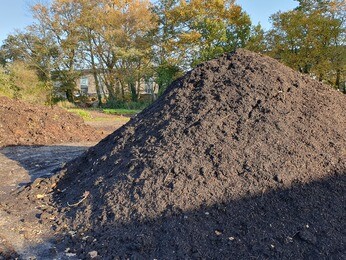
The first thing we knew we’d rather not do was cut anything back, from the lessons learned in 2018. But where plants had collapsed, we decided one way to tackle it was to cut a plant down but use the leftover material cut into small pieces as a mulch on top of the crowns, to shade them and act as a bit of sunscreen. This was a painfully slow process. Normally the mulch we use is bought-in composted green-waste and we had already begun pouring this down the gaping cracks in the clay. So we decided to go ahead and use the usual mulch instead.
It's recommended that mulch is added when the soil beneath is wet in order to seal in moisture, yet here we were, adding another layer of dry to an already dry and hot soil. We didn’t know if it was going to work but it instinctively felt like the right thing to do, to protect the crowns and help roots and shoots survive the incredible heat.
It was surprising to see how the decline in many plants was halted over-night, as drooping leaves stopped wilting. The soil below the mulch felt a little cooler than the surface of the mulch. The mulch had literally acted as a sunscreen. The worry was that any rain we now had would have to be enough to penetrate this mulch - and that was unlikely for some time. However, the difference between rain and irrigation is that rain is across an entire area and moisture entering the lawn, say, will find its way through the soil, so on the whole, we thought it was worth trying.
Did we succeed in saving plants?
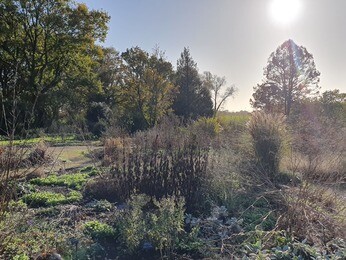
November 2022: although many plants were eventually cut back after the intense heat had passed, much was left standing adding to the autumn structure of the Reservoir Garden
Some successes were obvious from September, such as asters that began to flower with only their stunted height revealing the stresses they were put under this summer. Other plants put on new shoots once the temperatures cooled and there was plenty of rain. It has helped that we’ve have a mild autumn - and recently, plenty of rain as well. There will be some plants that we won’t know if they have survived until they come back (or not) next spring.
In the Gravel Garden, which turned shades of brown, gold and black from July onward, there were a few losses. The mulch in the Gravel Garden is the gravel itself and you can imagine how hot that can become. For example, lots of thyme lost their leaves, and while most have now regrown quite happily, a few have not.
What to expect in a drought
For some of our visitors, what they saw around the garden, especially the Gravel Garden, was incomprehensible. Why are there lots of dead plants? they asked. Explaining about summer dormancy was a conversation we had quite a few times this summer. In hot climates, people understand and expect summer dormancy in plants. Imagine a Greek island landscape in August where the only green to be seen is perhaps in an olive grove or some holm oaks. But here in the normally balmy climate of the UK where we’re used to everything being green from March to November, it can be hard to fathom.
Not that everything brown was dormant. Sadly, some plants did succumb to the heat or the drought. But we are going to go through and look at which plants might need re-categorizing as drought tolerant or not for the new reality of hotter summers, as well as less rainfall.
Here is a blog written in mid-August listing the plants growing in the Reservoir Garden which were coping well with the drought conditions: How the Garden is Coping With Drought 2022
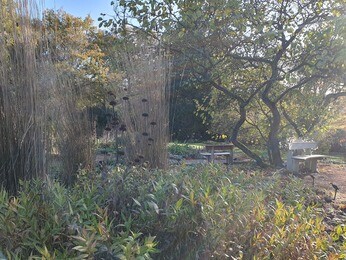
Read on: Top 12 Drought Resistant Plants

Written by Gardener Sally
![]()
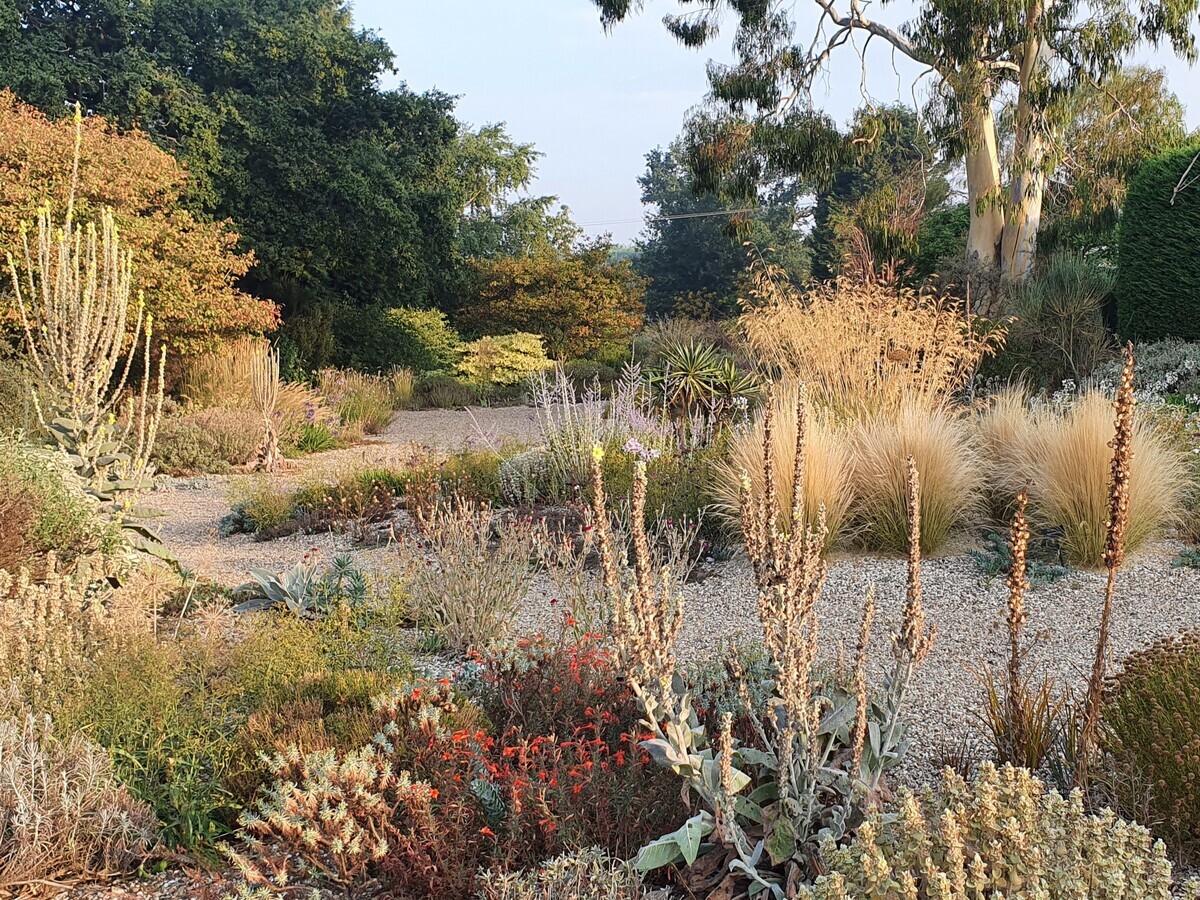
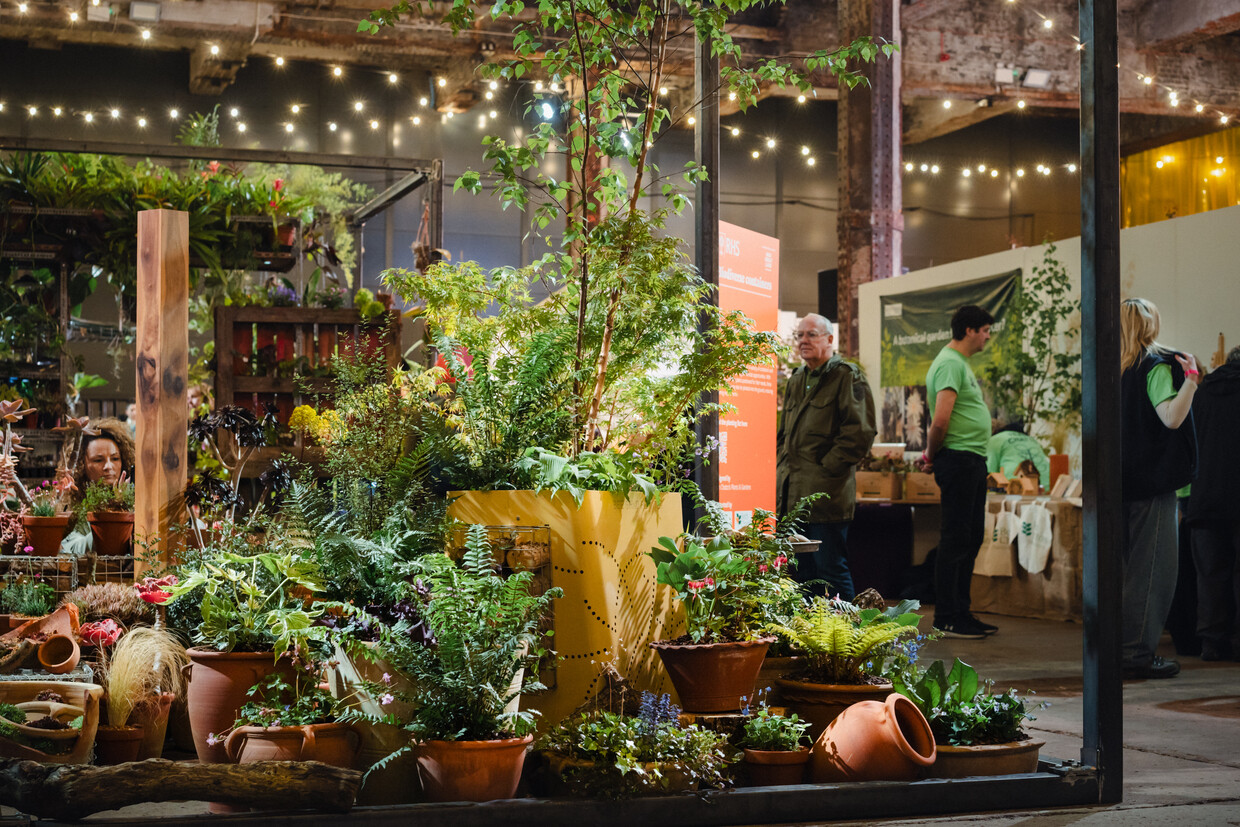

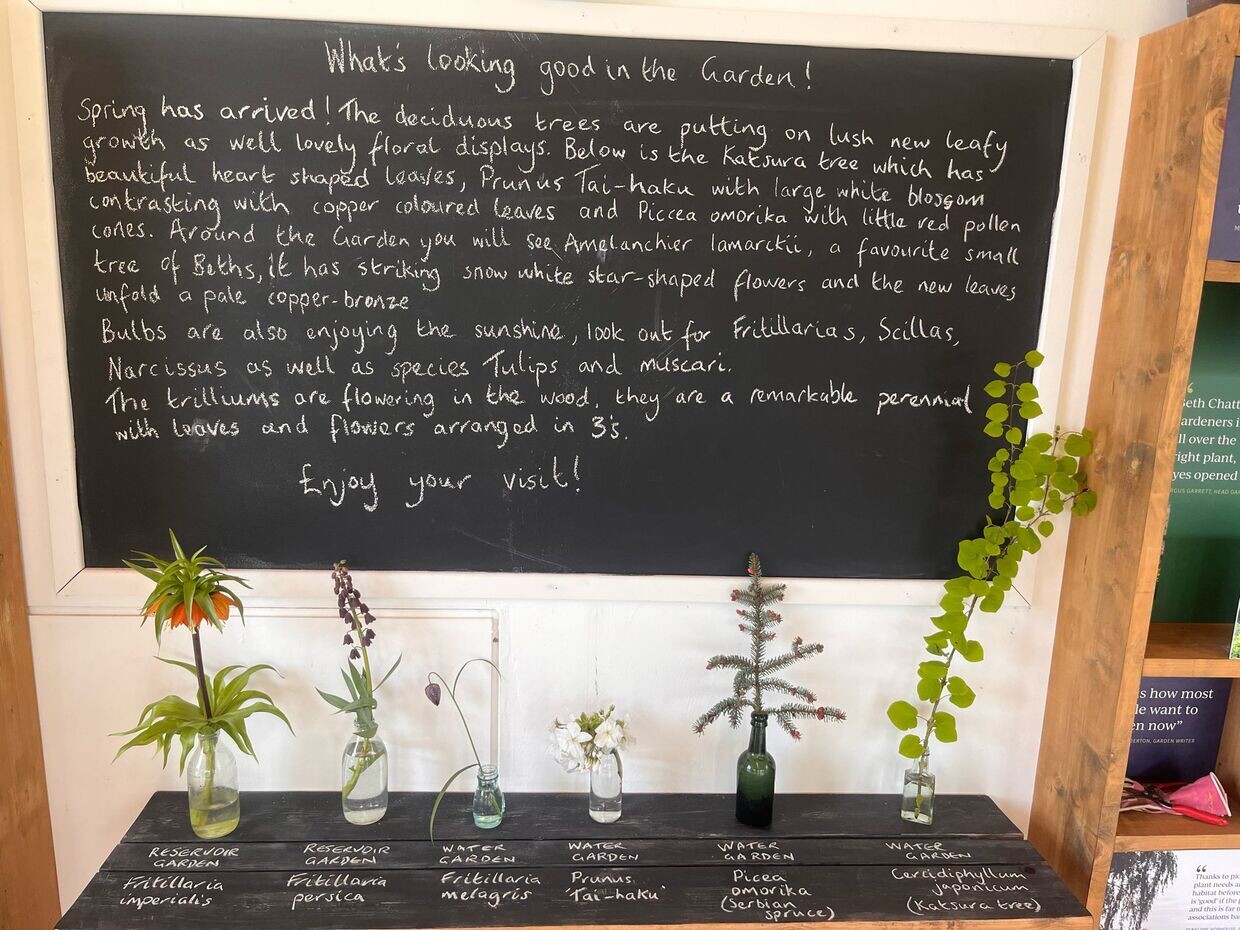
Comments